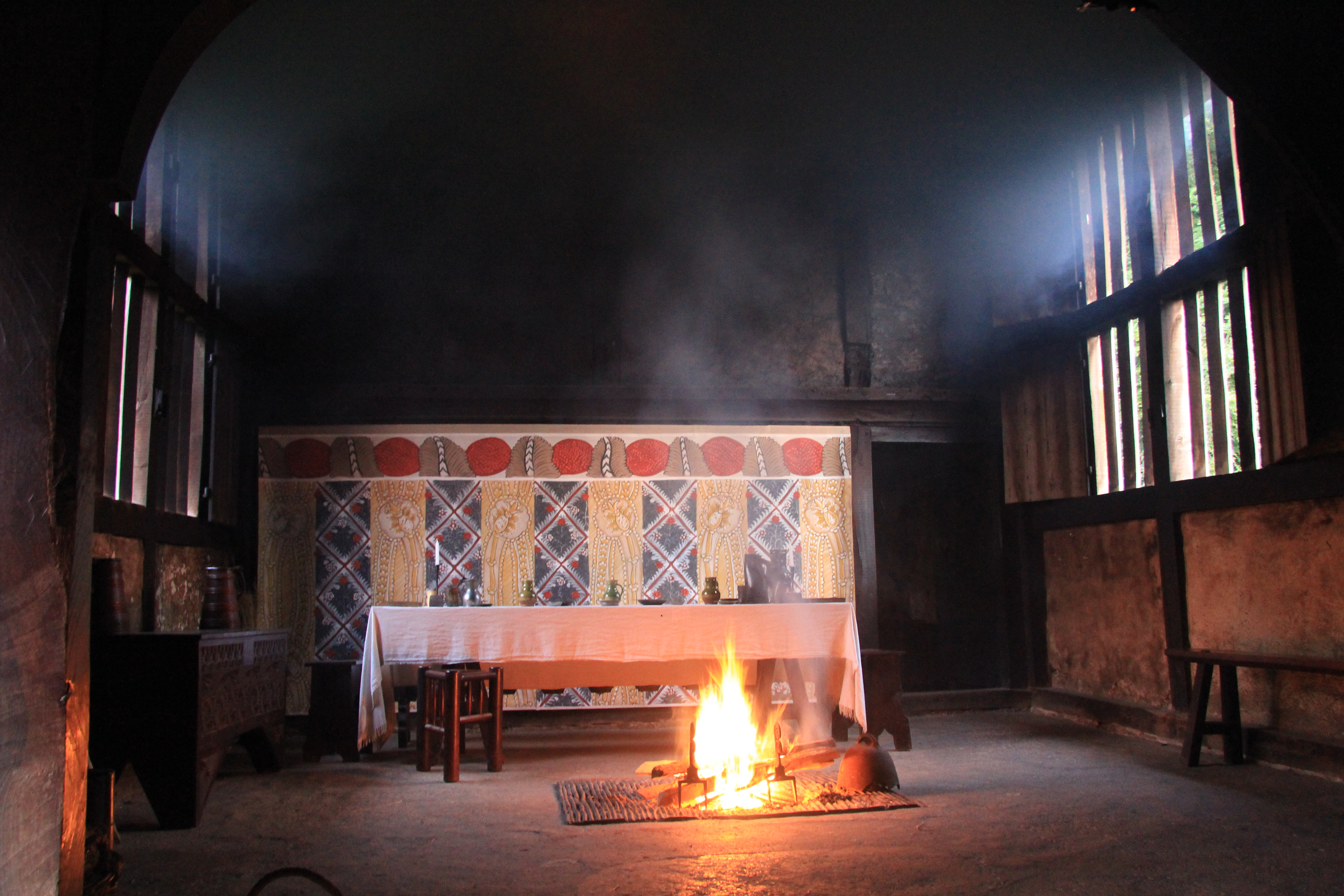The Geffrye Museum of the Home, 12th September 2013
The series of painted cloths at Owlpen Manor (listed Grade I), in Gloucestershire, is recognised as probably the most complete scheme of later painted cloths extant—and still in situ—in England. They relate to a workshop of cloths similar in style and technique discovered in recent years at various sites in the southern half of England.
They illustrate Old Testament scenes from the life of Joseph and his brothers against a stylised background of conical hills, forest work, animals and exotic buildings representing the Holy Land. They are painted in a traditional glue tempera technique on 42-inch strips of coarse linen canvas.
They were installed following the well-documented early Georgian reordering of the east wing of the manor house after it had been inherited by Thomas Daunt IV, where they are recorded in his account book in 1723.
The manor was virtually unoccupied for 80 years to 1925, when they remained ‘sleeping’ in the same dry upper bedchamber where they were first hung, and begin to be described in the first antiquarian accounts.
Finally, they were cleaned and conserved by Elsie Matley Moore, an early authority on painted cloths, in 1964, when they were reduced in height and rehung in an adjacent Tudor bedroom, considered at the time more appropriate for their display to the public.
Today their rare survival gives a privileged insight into ideas of interior decoration in the early modern period. Recently, a number of reproductions have been made to enhance the ‘authentic’ interpretation of historic interiors in museums and houses open to the public.
Ben Tatler and Ross MacDonald, School of Psychology, University of Dundee, ‘Perceptions of early modern interiors: the evidence of eye tracking’.
This paper outlined the nature of vision and perception, and described some of the experiments which have demonstrated changes in both in relation to two-dimensional art objects as opposed to three-dimensional spaces, and the status of the viewer as ‘expert’ or ‘novice’. It outlined the nature of the experiment undertaken at Owlpen Manor, showing the information fed to the participants between each of their viewings of the room in which the cloths are displayed, and a range of sample movies from the tracking equipment were shown. The findings of the experiment were then described, in terms of differences in ‘looking time’ between participants and on distinct areas of the room and the tapestries and mean visit and gaze times. The conclusions suggested significant and intriguing distinctions in viewing practice based around the levels of expertise of the participants and the kind of information they were given between the different sections of the experiment.
Session 4, 3:45 – 4:45:
Chris King, University of Nottingham and Anthony Masinton, University of York, ‘Experiencing the early modern town house: digital visualisation of domestic interiors at Strangers’ Hall, Norwich’
This paper will present the preliminary results of a digital visualisation project at Strangers’ Hall Museum, Norwich, being undertaken by Chris King of the University of Nottingham and Anthony Masinton of the University of York. Strangers’ Hall is a complex multi-period merchants’ residence, home to successive mayoral families, and opened in the early 20th century as one of Britain’s first museums of domestic life. Combining interdisciplinary research into the structure of the building and historic domestic interiors and furnishings, the aim of the project is to produce a digital visualisation of a ‘parlour’ in its different guises through the 16th and 17th centuries, and using this as a site to explore changes in the appearance and function, status and meanings of early modern urban living and dining spaces. This project begins with a commitment to critically explore the process of visualisation itself, as a research tool which highlights gaps in understanding and opens up new routes of enquiry, enabling the investigation of qualitative experience and change through time within an historic interior. It allows the researcher to view and move through the evidence systematically and comprehensively but can also be used highlight ambiguities, alternative explanations and gaps in knowledge. Although at an early stage, the visualisation is prompting new questions about the development of Strangers’ Hall and other elite townhouses in Norwich, and we hope that the methodology can be developed into a wide-ranging project that will enhance both academic research and public understanding of medieval and early modern domestic interiors.
Dr Dinah Eastop, Curatorial Research Fellow, The National Archives, Kew, UK, ‘New ways of engagement: interactive images online’
Digital technologies provide new ways to share and explore decorated domestic interiors, and to create representations of them. In considering options for putting a diverse collection of nearly 3 million designs online we have considered options for conveying the 3-dimensional, textured surface of some designs (e.g. woven textiles, straw-work, embossed papers). With the help of colleagues at the University of Southampton, we’ve used a novel image capture and processing technique which allows the user to ‘relight’ the on-screen ‘object’. This virtual re-lighting is very easy to use, and provides a pro-active experience of examination, as the viewer can direct the lighting to meet his/her needs. When combined with a zoom facility, it provides a very useful and engaging mode of investigation. Polynomial texture mapping (PTM) is particularly useful for inspecting monochrome, textured surfaces. There will be an opportunity to inspect two test pieces (cloth and basketry), to compare them with their digital surrogates, and to use the re-lighting and zoom options. N.B. The examples shown in the presentation and demonstration are outside the period covered by the conference. The presentation will include designs from the Board of Trade Design Register, 1839-1991. Links to the PTMs on The National Archives’ website are noted below.
http://blog.nationalarchives.gov.uk/blog/capturing-and-exploring-texture/
http://blog.nationalarchives.gov.uk/blog/texture-mapping-part-two/
http://blog.nationalarchives.gov.uk/blog/texture-mapping-part-three/
http://blog.nationalarchives.gov.uk/blog/texture-mapping-part-four/
http://blog.nationalarchives.gov.uk/blog/new-light-on-old-seals/
